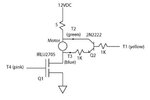Involute
Newbie level 2
Help with an electronic brake for a DC motor
I have a small 12VDC motor (250 mA max.) that I'd like to add an electronic brake to. I control the motor (on/off) from a micro driving a mosfet on the motor's low side (see Brake.jpg for schematic). To brake the motor, I'd like to short the motor's contacts (after turning it off first, of course), which I'm trying to do via a 2N2222. This has no effect, though I've confirmed that physically shorting the contacts immediately after killing the power to the motor has the desired effect. I've attached a shot of the traces from my scope; the points where the probes connect to the circuit are indicated on the schematic by color and number ("T1" is trace 1).
You can see that when the motor is switched off (T4 goes low), the brake switches on (T1 goes high) for 250 ms, but there's no change in the voltage across the motor contacts (T2 and T3). I assume the ramp on T3 after the motor is turned off is the dissipating inductance.
Any ideas what I'm doing wrong? I'm a newbie, so it's probably something dumb and obvious. Thanks for the help.
PS - Sorry if this is the wrong forum. It seemed like the best match, if not perfect. Feel free to point me to the right one.
I have a small 12VDC motor (250 mA max.) that I'd like to add an electronic brake to. I control the motor (on/off) from a micro driving a mosfet on the motor's low side (see Brake.jpg for schematic). To brake the motor, I'd like to short the motor's contacts (after turning it off first, of course), which I'm trying to do via a 2N2222. This has no effect, though I've confirmed that physically shorting the contacts immediately after killing the power to the motor has the desired effect. I've attached a shot of the traces from my scope; the points where the probes connect to the circuit are indicated on the schematic by color and number ("T1" is trace 1).
You can see that when the motor is switched off (T4 goes low), the brake switches on (T1 goes high) for 250 ms, but there's no change in the voltage across the motor contacts (T2 and T3). I assume the ramp on T3 after the motor is turned off is the dissipating inductance.
Any ideas what I'm doing wrong? I'm a newbie, so it's probably something dumb and obvious. Thanks for the help.
PS - Sorry if this is the wrong forum. It seemed like the best match, if not perfect. Feel free to point me to the right one.

